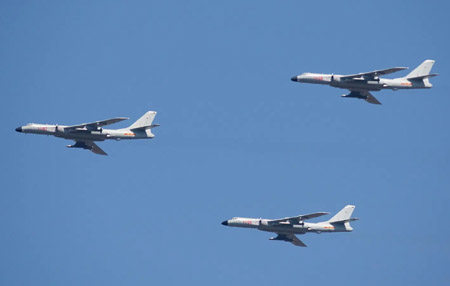by WorldTribune Staff, December 29, 2020
Over the last five years, Chinese bombers have ventured deep into the South China Sea and proven their ability to surround Taiwan.
Over the next few years, communist China plans to build up to 9 to 12 new “brigades” of bombers, each with 32 aircraft. It is part of supreme leader Xi Jinping’s strategy to “terrorize Taiwan into surrendering its freedom,” a military specialist noted.

The question is, will Taiwan and the United States be able to deter China’s plans, Richard Fisher, a senior fellow with the International Assessment and Strategy Center, wrote in a Dec. 28 analysis for the Taipei Times.
Taiwan, under President Tsai Ing-wen, and the United States under President Donald Trump, “started a long overdue buildup of defensive capabilities to deter military aggression by the Chinese Communist Party (CCP) dictatorship,” Fisher wrote. “The problem is that developmental and funding timelines dictate that the balance of these planned capabilities, assuming they are continued by successor governments, will not be deployed to deter a Chinese invasion of Taiwan until the mid-2020s.”
Fisher asked: “Can military capabilities that largely exist today sufficiently scare CCP dictator-for-life Xi Jinping from adding millions of Taiwan invasion victims to the 1.7 million global victims of his Wuhan Coronavirus?”
Xi’s Taiwan invasion calculations “may in large part be determined by the bomber force balance between the People’s Liberation Army (PLA) and the U.S.,” Fisher noted.
PLA bombers will carry a large proportion of the more than 2,000 PLA theater missiles that will attack Taiwan’s military bases, and U.S. forces in Japan, Guam, and other bases. For the U.S. Indo-Pacific Command, its bomber forces offer the most rapid option for launching a massive non-nuclear attack against a PLA invasion of Taiwan.
Estimates say the addition of 9 to 12 new bomber brigades would bring China to between 288 and 384 bombers. Assitionally, in 2021 Xian may reveal its new stealthy flying-wing configured bomber, often called the “H-20,” that will have an intercontinental range.
“With new Xian Aircraft Corporation Y-20U large tanker aircraft coming online, expect modernized Xian H-6N ballistic missile-carrying bombers, escorted by refuelable Shenyang J-16 heavy fighters and J-20 5th-generation fighters, to exercise near the critical US bases on Guam or even probe the defenses of Hawaii. Both fighters now carry the deadly 200km range Luoyang PL-15 air-to-air missile (AAM),” Fisher noted.
The U.S. Indo-Pacific Command, Fisher noted, “can draw on a U.S. Air Force bomber force consisting of 20 Northrop-Grumman stealthy flying-wing subsonic speed B-2 bombers and 78 Boeing B-52H subsonic bombers built in the 1960s. They are now beginning an engine upgrade and electronics modernization program that could extend their service life to the 2050s—nearing 100 years of service for this type. After retiring 17 older aircraft in 2021, the USAF will also have 45 supersonic speed capable Boeing B-1B bombers.”
Provided their bases have not been attacked by PLA missiles and attacking PLA fighter aircraft can be held at bay, a combined force of 24 B-1B and B-52 bombers can attack 650 PLA targets on land or at sea with precision-guided missiles. “Double the bombers and it becomes possible to sink most of the 1,000+ civil transport ships that will carry the bulk of the PLA’s Taiwan invasion force,” Fisher wrote.
Meanwhile, Fisher noted that “Taiwan’s ability to counter PLA bombers can be greatly enhanced by the U.S. sale of KC-135 aerial refueling tankers, and early sale of new 200km range US AAMs. A small number of tankers, four or so, could extend the range of Taiwan’s F-16 fighters, forcing H-6K bombers to loiter off of Taiwan beyond the range of their cruise missiles.”
As CCP-PLA intimidation, especially bomber intimidation, is likely to increase in 2021, Taiwan and the U.S. “should consider their own brand of counter-intimidation,” Fisher wrote. “They could build scores of large 200 meter-long plastic card and wood, very lightweight ships configured to simulate invading PLA Navy or civilian ferry ships. Repeatedly sinking 50 of these target ships with two B-1B or B-52H bombers during multiple highly publicized exercises could go far to convince Xi Jinping and the PLA that an invasion of Taiwan will result in their ships and soldiers meeting a quick watery grave.”
Intelligence Brief __________ Replace The Media
